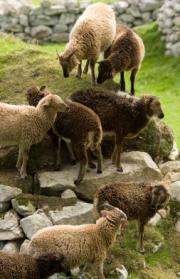Climate change and the mystery of the shrinking sheep

(PhysOrg.com) -- Milder winters are causing Scotland's wild breed of Soay sheep to get smaller, despite the evolutionary benefits of possessing a large body, according to new research due to be published in this week's Science Express (2 July).
The new study provides evidence for climate change as the cause of the mysterious decrease in the size of wild sheep on the Scottish island of Hirta, first reported by scientists in 2007. The researchers believe that, due to climate change, survival conditions on Hirta are becoming less challenging, which means slower-growing, smaller sheep are more likely to survive the winters than they once were. This, together with newly-discovered so-called 'young mum effect' whereby young ewes produce smaller offspring, explains why the average size of sheep on the island is decreasing.
Classical evolutionary theory suggests that over time the average size of wild sheep increases, because larger animals tend to be more likely to survive and reproduce than smaller ones, and offspring tend to resemble their parents. However, among the Soay sheep of Hirta, a remote Scottish island in the St Kilda archipelago, average body size has decreased by approximately 5% over the last 24 years.
The research team analysed body size and life history data, which records the timing of key milestones throughout an individual sheep's life, for Soays on Hirta over this 24 year period. They found that sheep on the island are not growing as quickly as they once did, and that smaller sheep are more likely to survive into adulthood. This is bringing down the average size of sheep in the population over all.

Professor Coulson suggests that this is because shorter, milder winters, caused by global climate change, mean that lambs do not need to put on as much as weight in the first months of life to survive to their first birthday as they did when winters were colder.
He explains: "In the past, only the big, healthy sheep and large lambs that had piled on weight in their first summer could survive the harsh winters on Hirta. But now, due to climate change, grass for food is available for more months of the year, and survival conditions are not so challenging - even the slower growing sheep have a chance of making it, and this means smaller individuals are becoming increasingly prevalent in the population."
Their results suggest that the decrease in average body size seen in Hirta's sheep is primarily an ecological response to environmental changes over the last 25 years; evolutionary change has contributed relatively little.
In addition, the research team also discovered that the age at which a female sheep gives birth affects the size of her offspring. They realised that young Soay ewes are physically unable to produce offspring that are as big as they themselves were at birth. This 'young-mum' effect had not been incorporated into previous analyses of natural selection, which explains in part why the sheep of Hirta are defying biologists' expectations.
"The young mum effect explains why Soay sheep have not been getting bigger, as we expected them to," concludes Professor Coulson, "But it is not enough to explain why they're shrinking. We believe that this is down to climate change. These two factors are combining to override what we would expect through natural selection."
More information: 'The Dynamics of Phenotypic Change and the Shrinking Sheep of St. Kilda', Science Express, Thursday 2 July, 2009.
Source: Imperial College London (news : web)
















